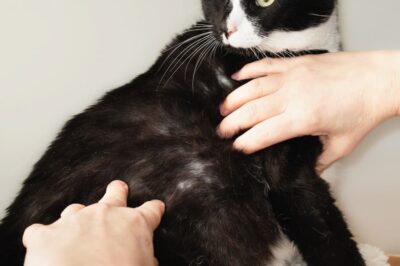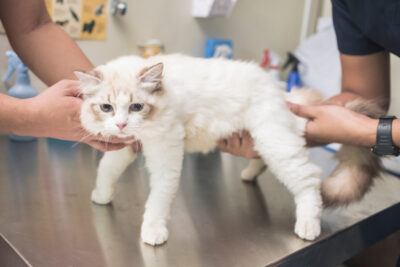Demodex Mites in Cats (Feline Demodicosis)

All featured products are chosen at the discretion of the GreatPetCare editorial team and do not reflect a direct endorsement by the author or reviewer.
Your cat is itching, has lost some hair, and their skin is red. Could it be demodex mites?
Demodex mites on cats are microscopic parasites that can cause itching, ear infections, and hair loss (1). While demodex mites are rarer in cats than in dogs, they do exist and can make your cat miserable.
Read on to learn more about demodex mites in cats, including how cats can become infected and signs to watch for. We’ll also cover how veterinarians diagnose and treat this skin condition in cats, also known as feline demodicosis.
What Are Demodex Mites in Cats?
Demodex mites are tiny external parasites that live on both cats and dogs. They are too small to see with the naked eye, so you need a microscope to view them. Like spiders, demodex mites belong to the arachnid family. Scientists have discovered around 65 species of demodex.
Researchers have described three species of demodex in cats: Demodex cati, Demodex gatoi, and a third unnamed Demodex species (2).
- Demodex cati has a long body and lives in the ears and hair follicles.
- Demodex gatoi has a short body and lives on the surface of the skin.
- The unnamed Demodex species has a blunt abdomen and lives in the hair follicles. It is often found concurrently with D. cati.
All cats are at risk for demodex. However, Burmese, Maine Coons, Siamese, and Bengals seem predisposed. In addition, D. gatoi is very contagious, so cats who live in multi-cat households are at increased risk for this species. Demodex mites are present globally. However, veterinarians diagnose D. gatoi more often in cats who live in the southern United States, especially Texas and Florida.
Demodex infestations in cats go by several names, including feline demodex, feline demodicosis, and demodectic mange in cats (3, 4).
How Do Cats Get Demodex Mites?

Transmission of cat demodex mites depends on the species. The highly contagious D. gatoi passes from cat to cat on contact. D. gatoi infections are challenging because some infected cats do not show any signs (they’re asymptomatic) and they can still infect other cats.
D. cati, on the other hand, is not contagious and is not spread from cat to cat. Cats who have generalized skin disease due to D. cati usually have an underlying metabolic disorder, immune disorder, or are receiving an immunosuppressive medication that allows the mites to multiply. If your cat has D. cati, your veterinarian may recommend testing for immune disorders, such as feline leukemia, FIV, Cushing’s syndrome, diabetes, or cancer.
Can humans get demodex mites from cats? Fortunately, the answer is no. Demodex mites are species-specific, meaning they can only live on their host species. That means cats cannot get demodex from dogs or humans, and vice versa.
Demodex Mites in Cats Symptoms

Feline demodex can cause problems in one area of the skin or the cat’s whole body. Some cats may have no signs at all.
Most cat demodex mite infestations result in increased itching. This causes excessive grooming and hair loss on the parts of the body that the cat can reach, including the legs, hips, chest, and belly. Additional signs of demodex in cats vary depending on the species of mite:
- Cats infested with D. cati often experience hair loss, redness, crusty skin, and ear infections. D. cati typically causes skin problems on the face, head, and neck but can spread to the rest of the body.
- Cats infested with D. gatoi may be extremely itchy. Additional symptoms associated with this mite include red skin, lip ulcers, and miliary dermatitis.
Diagnosing Demodex Mites in Cats

If you think your cat has demodex mites, then you need to schedule a vet appointment. In most cases, your veterinarian will use a combination of oral history, physical examination of your cat, and skin tests to diagnose demodex. The most common skin test they use to diagnose mites is a skin scrape. Your veterinarian will take small samples from the surface of your cat’s skin in multiple places and then examine the samples under a microscope.
Since demodex can mimic several other skin diseases, including ringworm, your veterinarian may run additional skin tests to rule out other diseases. In addition, your veterinarian may have trouble finding demodex on your cat because cats often groom off mites. If your vet doesn’t find mites but is still suspicious that your cat has them, they can monitor your cat’s response to mite treatment to confirm the diagnosis.
Demodex in Cats Treatment
If you are wondering how to get rid of demodex mites on cats, rest assured that the treatment of feline demodicosis is fairly straightforward and simple. However, treatment depends on the type of demodex mite your veterinarian diagnoses. Your veterinarian will prescribe the appropriate treatment for your cat. This may include:
Topical fluralaner (Bravecto)
Topical selamectin and sarolaner (Revolution Plus)
Oral ivermectin (Heartgard)
Oral milbemycin (Interceptor)
Topical moxidectin (Advantage Multi)
Topical selamectin
Topical lime sulphur dips (not commonly used anymore)
Topical amitraz dips (not commonly used anymore)
The cost of treating demodex mites in cats varies, but generally costs less than $100.
A couple of important reminders:
- Each treatment has its own list of pros and cons. Your veterinarian is your best resource to help you decide the best treatment for your cat.
- In addition to eliminating the mites, your veterinarian may also prescribe antibiotics for any secondary bacterial infections or anti-itch medication if your cat is itchy.
- Cats suffering from generalized skin disease due to D. cati often have an underlying disorder that a vet needs to diagnose and treat. Sometimes, a D. cati infestation can be resolved by treating the underlying condition.
- Again, D. gatoi is very contagious to other cats. If your cat has D. gatoi and you have other cats at home, you should treat all cats in the household.
- Mites do not live in the environment, so there is no need to do any environmental cleaning.
- Home remedies are typically not successful in eliminating external mite parasites.




How to Prevent Demodex Mites in Cats
While mites may be a pain, they are relatively easy to treat and even easier to prevent. Giving your cat regular preventative medication that eliminates external parasites like fleas and ticks often is effective against skin mites as well. Ask your vet which product they recommend to keep all the creepy crawlies away from your cat.
In addition to regular parasite control, the following steps can reduce your cat’s risk of developing a skin mite infestation:
- Keep your cat indoors and away from other cats with unknown health histories
- Have a veterinarian examine your cat regularly to catch problems early. If you notice any signs of sickness in your cat, get them seen as soon as possible
- Feed your cat an appropriate amount of complete and balanced cat food
- Do not use medications in your cat that cause immunosuppression (such as steroids) unless directed to by a licensed veterinarian
Related Conditions
- Pyoderma
- Flea allergy dermatitis
- Dermatophytosis (ringworm)
- Cheyletiella
- Otodectes cynotis
- Other causes of otitis externa
- Ingredient hypersensitivity (food allergy)
- Feline atopy
- Psychogenic alopecia
References
- Grant, David. Diagnosing and treating feline demodicosis. Improve Veterinary Practice. April 2019. Accessed online: https://www.veterinary-practice.com/article/diagnosing-and-treating-feline-demodicosis
- Beale, Karin. “Feline demodicosis: a consideration in the itchy or overgrooming cat.” Journal of feline medicine and surgery vol. 14,3 (2012): 209-13. doi:10.1177/1098612X12439268
- Young, Silene. Feline demodicosis: prevalence, diagnostics, treatment. DVM360. May 2010. Accessed online: https://www.dvm360.com/view/feline-demodicosis-prevalence-diagnostics-treatment
- Brooks, Wendy. Demodectic mange in cats. Veterinary Partner. May 2021. Accessed online: https://veterinarypartner.vin.com/default.aspx?pid=19239&id=4951886









